Sleep-related issues are problematic for anyone who suffers from them. They run the gamut from short-term trouble falling asleep to full-blown sleep disorders that persist for years. Sleep problems can be particularly troublesome for people with autism spectrum disorder, also known as ASD.
Difficulty with sleep can affect adults and children with ASD in two ways: by exacerbating autism-related symptoms and causing issues related to sleep deprivation or excessive sleep. Learning how these disturbances impact people with ASD can help parents and partners understand the challenges of sleep and autism, and explore ways to relieve symptoms.
Note: The content on Sleepopolis is meant to be informative in nature, but it shouldn’t take the place of medical advice and supervision from your healthcare provider. If you feel you, your child, or partner may be suffering from any sleep disorder or medical condition, please see a trained professional immediately.
What is Autism Spectrum Disorder?
ASD is a common neurodevelopmental disorder that likely results from a combination of genetic and environmental factors that impact the brain’s structure. (1) Autism may be recognized in infancy, but typically becomes more pronounced in early childhood. Though symptoms vary in severity, they often interfere with daily life and impact academic and social functioning.
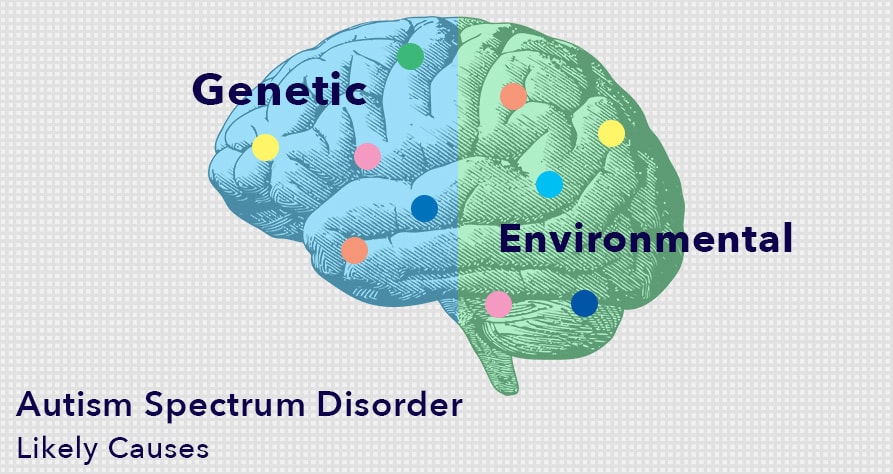
Signs and symptoms in both adults and children might include the following:
- Avoiding eye contact
- Having trouble recognizing or understanding their own feelings or those of someone else
- Avoiding physical contact, or allowing it only under certain circumstances
- Preferring to be alone
- Appearing uninterested in surroundings or objects that would interest others
- Difficulty pretending or playing other games that involve imagination
- Engaging in repetitive motions or activities (2)
- Expressing little interest in other people, or being unable to express interest through language or eye contact
- Responding to animals or objects but having trouble responding to other people
- Parroting words or phrases and/or using unusual words and phrases instead of appropriate language
- Having trouble adapting to even minor changes in routine or environment
Other common symptoms include unusual body postures or facial expressions, the need to abide by strict routines, and a preoccupation with certain objects or rituals. People with autism may have trouble expressing their needs, and lose academic or language skills they once had as they get older.
Some people with ASD show fewer or less severe symptoms than others. ASD may or may not involve intellectual and language deficits. (3) Some people with ASD are able to attend school and work, while others are severely impaired, with significant problems learning, functioning, and living independently.
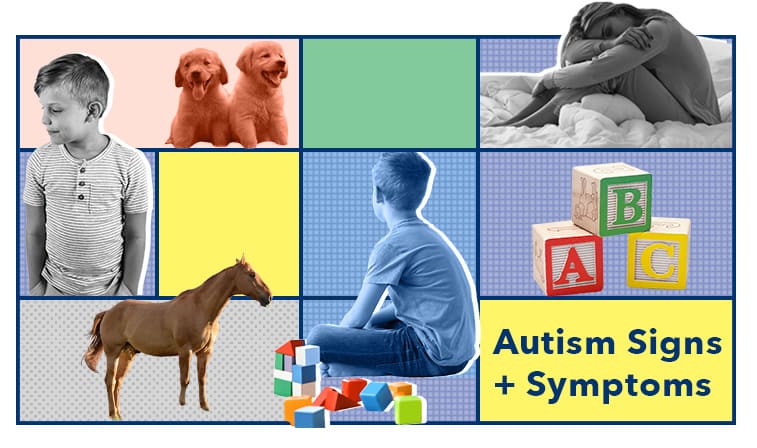
Criteria for Diagnosis of ASD
Autism used to be divided into distinct types, such as Asperger’s Syndrome and Rett Syndrome. These variations in behavior are now included under the broad term Autism Spectrum Disorder. Autism is called a spectrum because of the wide range of symptoms and symptom severity.
According to the criteria of the Diagnostic and Statistical Manual of Mental Disorders (DSM-5), symptoms must be present in the early period of development to be considered autism, though they may not be recognized until certain developmental milestones are delayed or don’t occur. (4) In addition, symptoms must not be better explained by another disability.
ASD is classified in the DSM-5 by the following levels of severity:
- Level One. Level One ASD is described as “requiring support” from parents or others. This level of ASD is characterized by impairments in social communication, including trouble initiating or responding appropriately to interactions. People with this level of ASD may have relatively good language skills but struggle with social cues and making friends
- Level Two. According to the DSM-5, Level Two ASD “requires substantial support” to help with significant impairments in language and social functioning. Deficits at this level are often problematic despite support. People with Level Two ASD have atypical verbal and nonverbal behavior and limited ability to interact with others
- Level Three. Level Three ASD is characterized by extreme difficulty with social interactions and verbal and nonverbal communication. People with Level Three ASD may be extremely resistant to changes in routine, and suffer from repetitive or restricted behaviors that interfere with social functioning and quality of life. They require “very substantial support,” and might have very limited ability to interact or live independently.
Effects of ASD
Effects of autism depend on the level of impairment and each individual’s abilities and personal circumstances. Effects of the disorder will be also impacted by early treatment and level of support. Some people with ASD will experience only a few of the possible effects, while others will experience many more.
Common effects of the disorder include:
- Social difficulties, trouble making friends, and social isolation (5)
- Family conflict
- Trouble with romantic relationships
- Difficulty at school and work
- The inability to attend school or get a job
- Difficulty living independently
- Trouble with proper nutrition and exercise
Sleep problems are also very common in people with autism spectrum disorder, no matter how severe their other symptoms. (6) Sleep issues may be one of the first symptoms that appear in early childhood, and continue for a lifetime.
Sleep and ASD

A significant number of people on the autism spectrum experience difficulty sleeping at some point in their lives. (7) Persistent difficulties may be an indication of a sleep disorder. Sleep disorders disrupt, change, or affect sleep in unfavorable ways that can impact health and quality of life. Poorer sleep in people with ASD is associated with worse cognitive, social, and intellectual functioning.
As many as 80% of people with autism have trouble sleeping. Children with ASD spend less time in REM sleep than other children, and sleep about an hour less at night.
People with ASD may experience a range of sleep symptoms, including:
- Difficulty settling down at bedtime
- Trouble staying asleep at night
- Problems falling asleep due to anxiety
- An inability to recognize the need to sleep in others who live with them
- An increased sensitivity to noise and light, including the blue light emitted from electronic devices such as smartphones
- Food allergies that disrupt sleep
- Problems with sleeping too much due to stress or behavioral issues
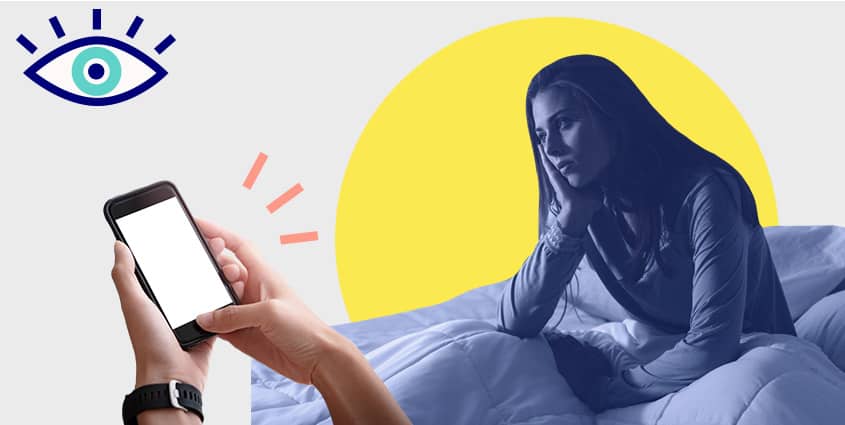
Sleep problems in people with autism can also cause increased stress for family, friends, and caregivers. People with ASD often become more symptomatic when sleep-deprived or if their sleep patterns are disrupted. This can present as increased hyperactivity, lack of attention, or other behavioral problems that may not appear related to sleep. Mood, coordination, and appetite are affected by poor sleep, and can indicate disrupted sleep even if the person with ASD does not appear tired.
Sleep Disorders and ASD
Sleep disorders occur frequently in autism, though symptoms may be different than in people without ASD. Insomnia is one of the most common ASD-related sleep disorders, and can be a problem in both children and adults. Symptoms may include:
- Difficulty falling asleep. People with autism can have trouble relaxing enough to fall asleep
- Difficulty staying asleep. Autism can cause or worsen episodes of waking during the night. Waking can occur just once, or many times over the course of a night
- Difficulty falling back to sleep. Once awake, people with ASD can have trouble falling asleep again. Time awake can last from minutes to hours
- Early waking. ASD can cause persistent waking in the early morning
People with autism may suffer from other common sleep disorders, as well. Bedwetting is more common in children with autism, and nightmares can be more upsetting for children with sensory deficits. They may also experience sleep disorders that are unrelated to autism, such as restless legs syndrome, narcolepsy, and sleep apnea. These disorders can worsen autism symptoms, or be made worse by the sensory issues typical of ASD. (8)
Sleep, Neurotransmitters, and Autism
Sleep is an essential biological process that involves a complex interplay of neurotransmitters, hormones, and signals from the circadian rhythm. Light and darkness signals and central nervous system arousal are important to sleep, as well. GABA (gamma-aminobutyric acid) is a neurotransmitter that promotes sleep by decreasing activity in the central nervous system and brain. Neurotransmitters that reduce the activity of other neurotransmitters are called inhibitory transmitters. In addition to its effect on sleep, GABA can reduce stress, increase feelings of calmness, and regulate mood.
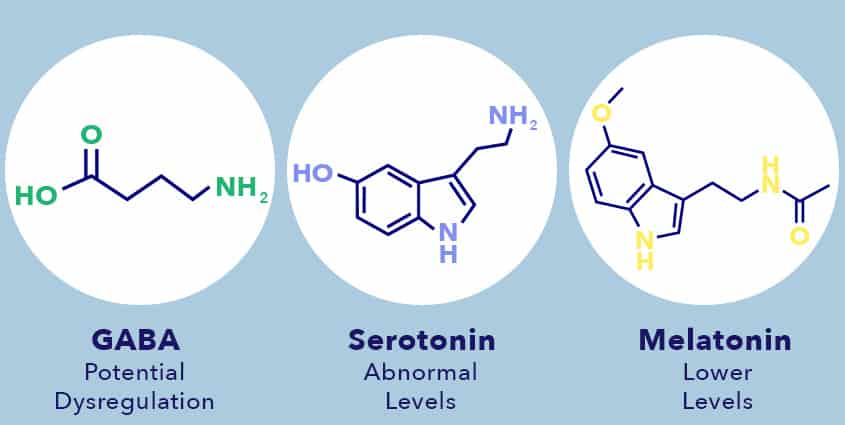
Autism appears to involve a dysregulation of GABA, which can disrupt sleep. People with ASD may have abnormal levels of serotonin, as well, which can affect the activity of “the sleep hormone” melatonin. (9) Numerous studies show lower than normal levels of melatonin in people with ASD. Current research points to a combination of cognitive and neurochemical factors that predispose people with autism to poor sleep. (10)
The Circadian Rhythm and Autism
The circadian rhythm is the 24-hour biological clock that regulates sleep using light and darkness cues. The circadian rhythm depends on three primary factors to regulate sleep and waking: light, time, and the release of melatonin. The master clock is located in the hypothalamus of the brain, and can also be found throughout the body in smaller “local” clocks in organs and muscle tissue.
A poorly regulated circadian rhythm is a common finding in people with ASD. (11) Some researchers suggest that circadian rhythm dysfunction can make it more difficult for autistic people to adapt to changes in their environment. Problems with circadian rhythm can reduce total sleep time, make falling asleep more difficult, and cause common symptoms of disrupted sleep, such as:
- Daytime sleepiness
- Difficulty controlling emotions
- Lack of energy and motivation
- Trouble learning and remembering new concepts
- Irritability
- Depression
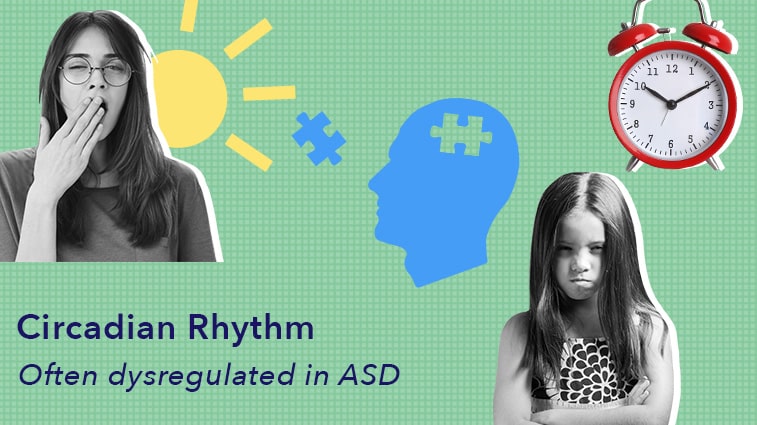
Separate studies on congenitally blind and deaf children show higher rates of autism in the blind children only. This suggests that the inability to process light signals through the eye might influence melatonin release, contributing to circadian rhythm dysfunction and ASD. (12) (13)
Sleep Tips for People with ASD
While sleep issues are difficult for people on the autism spectrum, certain strategies such as good sleep hygiene can be helpful. (14) Caregivers of people with ASD might try the following tips:
- See a sleep specialist about sleep disorders or persistent sleep problems. Treatments for insomnia, restless legs syndrome, sleep apnea, hypersomnia, and other disorders can significantly reduce symptoms in people with ASD and improve the quality of sleep
- Explain the need for sleep to children on the autism spectrum. Discussing sleep not only helps them understand its importance but can reassure them that sleep is safe and desirable
- Set up and stick to a sleep routine. A routine provides reassurance to people with autism, particularly children, and reduces changes that can affect their ability to sleep
- Keep a sleep diary to help reveal problematic sleep patterns. A sleep diary can also help doctors understand and treat autistic adults and children with sleep disorders
- Create a sleep environment that reduces sensory issues that can impact sleep. Ensure the physical sleeping space is conducive to rest, using cooling sheets, comfortable pillows, and a supportive mattress. Reduce light by using blackout curtains or blinds. Light, smells, and noise can be reduced by keeping doors closed during sleep time. To reduce the risk of disruptive smells, avoid cooking or using anything with a strong odor before bedtime or near the bedroom. Noise can be further reduced by using carpets in the home and moving beds away from walls that are adjacent to rooms with activity or traffic. Earplugs and a white noise machine can also lessen noise that might disrupt an autistic child or adult’s ability to sleep
- Remove objects that may distract from sleep, such as excessive toys and certain pictures on the walls. The feel of certain materials used for bedding and night clothes, tags, or labels may be uncomfortable or too stimulating against the skin. In addition to creating a relaxing environment, a soothing bath, gentle music, or reading a calming book may help people with autism relax and fall asleep more easily
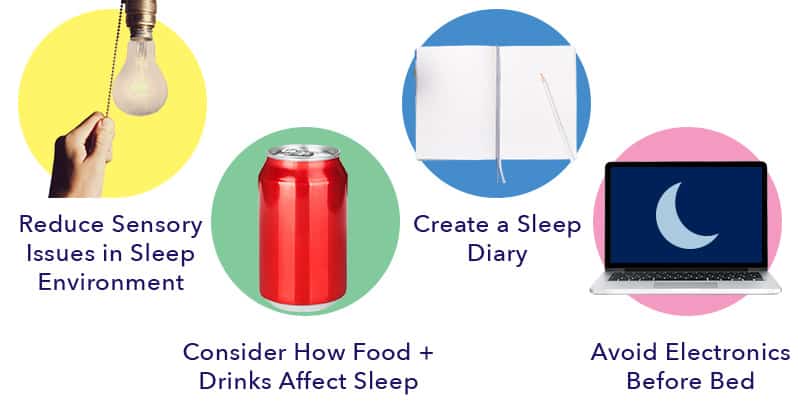
- Consider how food and drinks might influence the sleep of a person with ASD. Heavy meals, foods that raise blood sugar such as refined carbohydrates, and drinks with caffeine or sugar can interrupt or prevent sleep
- Encourage use of the bed for sleep only. Using the bed for other activities such as TV watching, game-playing, or reading can create an association between the bed and waking activities. Reserving the bed for sleep strengthens the psychological association between the bed and sleep
- Avoid electronics including TV, video games, computers, and phones before bed. Electronics emit blue light, which can prevent the release of melatonin by the brain and disrupt sleep. If electronics must be used, blue light-blocking glasses may help limit exposure to blue light and reduce its effect on sleep
- If necessary, discuss medications with your healthcare provider. Prescription medications are typically a last resort, but may be useful for short-term treatment. These medications might include benzodiazepines such as Valium and hypnotics such as Lunesta. In some cases, doctors may recommend melatonin, valerian root extract, or other over-the-counter remedies to help balance the sleep-wake cycle. Natural remedies such as acupuncture and yoga may present another option to soothe and relax a person with ASD. Check with a doctor before trying any sleep treatment yourself, or with someone who suffers from autism.
Last Word From Sleepopolis
Autism Spectrum Disorder can have a significant negative impact on sleep. People with autism of all severity levels might have trouble falling asleep, staying asleep, or falling back to sleep, or they might sleep excessively. Some may experience nightmares and other sleep disruptions related to sensory issues. Good sleep hygiene and other healthy habits can help people with ASD reduce anxiety and establish a reassuring routine that promotes sleep. There may also be a role for medications and natural or over-the-counter sleep supplements. Most of these are for short-term use only, and should be used under a doctor’s supervision.
More research will help us understand the link between sleep and autism, and may lead to additional treatments that help people with ASD sleep better despite the challenges of their disorder.
References
- Geoffray MM, Nicolas A, Speranza M, Georgieff N., Are circadian rhythms new pathways to understand Autism Spectrum Disorder? Journal of Physiology, Paris, November, 2016
- Morgan L, Wetherby AM, Barber A., Repetitive and Stereotyped Movements in Children with Autism Spectrum Disorders Late in the Second Year of Life,Journal of Child Psychology and Psychiatry, May 22, 2008
- Bal VH, Kim SH, Cheong D, Lord C., Daily living skills in individuals with autism spectrum disorder from 2 to 21 years of age, Autism, October 2019
- Weitlauf AS, Gotham KO, Vehorn AC, Warren ZE., Brief Report: DSM-5 “Levels of Support:” A Comment on Discrepant Conceptualizations of Severity in ASD, The Journal of Autism and Developmental Disorders, April 17, 2014
- Debbie Spain, Social anxiety in autism spectrum disorder: A systematic review, Research in Autism Spectrum Disorder, August 2018
- The sleep/wake rhythm in children with autism, European Child & Adolescent Psychiatry, July 1995
- Stefano Gabriele, Blood serotonin levels in autism spectrum disorder: A systematic review and meta-analysis, European Neuropsychopharmacology, June 2014
- Prihodova I, Dudova I, Mohaplova M, Hrdlicka M, Nevsimalova S., Childhood narcolepsy and autism spectrum disorders: four case reports, Sleep Medicine, November 2018
- Stefano Gabriele, Blood serotonin levels in autism spectrum disorder: A systematic review and meta-analysis, European Neuropsychopharmacology, June 2014
- Ann M. Reynolds, Sleep and Autism Spectrum Disorders, Pediatric Clinics of North America, 2011
- Gena Glickman, Circadian rhythms and sleep in children with autism, Neuroscience and Biobehavioral Reviews, April 2010
- Brown R, Hobson RP, Lee A, Stevenson J., Are there “autistic-like” features in congenitally blind children? The Journal of Child Psychology and Psychiatry, September 1997
- Donaldson AI, Heavner KS, Zwolan TA., Measuring progress in children with autism spectrum disorder who have cochlear implants, Archives of Otolaryngology, Head and Neck Surgery, May 2004
- Devnani PA, Hegde AU., Autism and sleep disorders, Journal of Pediatric Neurosciences, October-December 2015


























